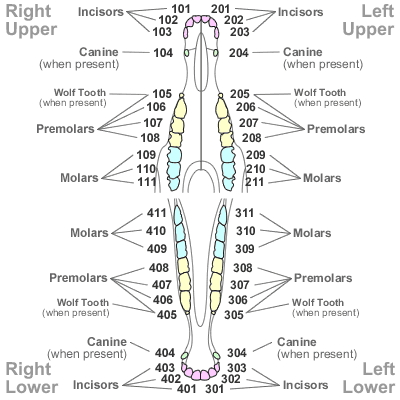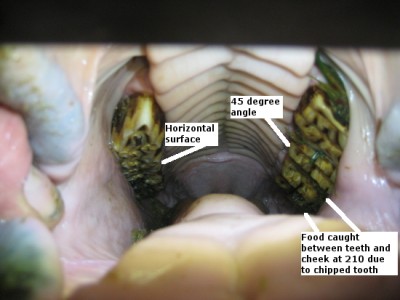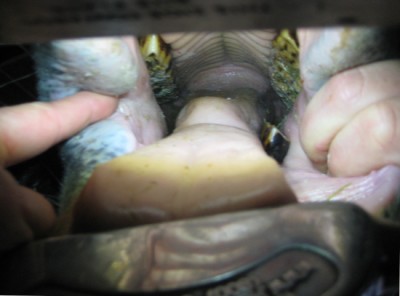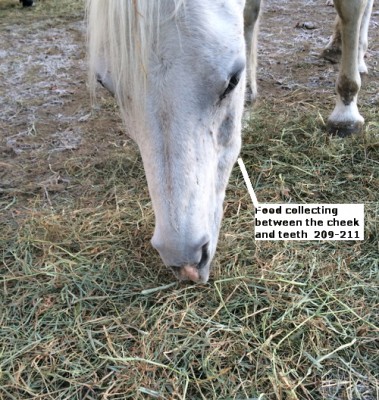Nutrition: Dental Visit #2 Case Study Elegance CF 2001gm
What a difference a dental visit makes! Before I show pictures of Elegance’s teeth before and after her dental work, let me first show an equine dental numbering chart :
The Triadan system in the horse. Based on an image supplied by David Crossley
My previous post showed Elegance’s upper left premolars and molars having a 45 degree wear angle. Now, with her sedated and her head supported by a padded “Y” stand, I can show you pictures of her mouth before the equine dentist, Ron Panarelli EqDP, began his work.
Her condition is called “Shear Mouth”. This is a condition that develops over years. They are not born with this and it is preventable. Notice all the chewed hay stuck between her teeth on the left side and her cheek. Also notice how swollen the tissues on the inside of her left cheek look. This picture was taken AFTER a thorough rinsing of her mouth.
Here is what her lower jaw on the left side looked at before Ron began his work.
As you can see the angle of her lower molars and premolars is the mirror image of her upper molars and premolars.
Because the teeth on the left had worn to this pathologic condition, she was doing all her chewing on the right side of her mouth.
She attempted to use the left but she had no side to side motion on that side with the jaw being blocked from sliding across those upper teeth due to the excessive angle of the upper arcade. This lack of motion which accounts for the wad of chewed hay (known as a quid) poking out the left side of her cheek.
There were also common equine dental problems on the right side of her mouth such as sharp points, hooks, and one ramp. These problems caused both pain in chewing and also restricted the forward and backward motion of the lower jaw. If a horse cannot move its jaw freely forward and backward and side to side when being ridden in any kind of bridle, bitless or with a bit, that lack of motion is going to cause the horse pain as the rider asks the horse to adjust its head carriage in response to pressure.
What was accomplished in this second visit:
- Reduction of excess transverse ridges (visit link equine dental procedures for a description ) on the surface of the teeth that are too tall or have a sharp point at the top. These ridges interfere with chewing by restricting front-to-back jaw motion and are unworn enamel and develop due to the soft diet domestic horses eat.
- Removed all buccal (cheek side ) and lingual (tongue side) points (visit link common equine dental problems for picture and description ).
- Removed 406 ramp ( visit link common equine dental problems for picture and description) .
- Removed 111 hook (visit link common equine dental problems for picture and description).
- Reduced buccal rim angle on upper left arcade (molars and premolars)
- Contoured caudal (back of) 209 to rostal(front of) 211 to help with food flow past the piece of molar gone from 210.
This was the first of several visits where Elegance will require veterinarian attended sedation and the use of power driven dental instruments. The equine dentist will visit her again in March 2016.
Elegance still has a long way to go but even this little improvement has made her more comfortable. She is brighter and she no longer requires her grain to be soaked so she can chew it. She is even spitting out quids (chewed but not enough) hay from that left side of her cheek which she couldn’t do before the this dental work.




In just a week after the dental visit, Elegance is now eating her grain without soaking it first, and she is clearing the hay that packs in her left cheek more often and I heard her grinding her teeth! I’ve NEVER heard her do that because she couldn’t move them right to left all the way across the chewing surfaces. She’s on her way to healing!
She will have a chiropractic visit on December 1, 2015 to make any necessary adjustments as a result of freeing up her jaw somewhat.
So Jeannie, how come the Dentist couldn’t fix her teeth in one or two visits?
best wishes
Bruce Peek
Bruce, it will take several visits to restore her chewing surfaces because to do it any faster will cause her more pain than she was in with her teeth the way they were. There are muscles and ligaments that have atrophied as a result of her limited mastication ability. Restoration needs to be done slowly so she has a chance to “adjust” to each correction.
This is not unlike lowering a falsely high heel on the hoof of a horse. If you take it off all at once the horse won’t be able to put his heel down because the tendons and ligaments haven’t stretched out yet so the horse is no better off than he was with the painful high heel. Slower is better in both cases.
Dear Jeannie: Oh I see. So ramps, and hooks and general mismatching of the teeth must be a fairly common occurrence. Sidekick had some mild slopes that the vet took down last spring, and yet he never showed many symptons at all..
Food for thought.
Best wishes
Bruce Peek
Dear Bruce, Good for your vet for attending to an imbalance. Yes, points and hooks are very common. Other issues less so. By the time horses become “symptomatic” for dental problems those problems are usually quite severe. Only because we humans aren’t sensitive enough to how the horse chews to notice little changes that indicate a problem before the symptom screams at us. Thanks so much for your interest in this. Dental problems are probably the most overlooked aspect of equine health care, IMHO. – Jeannie